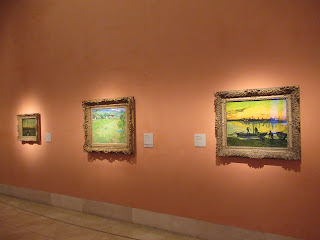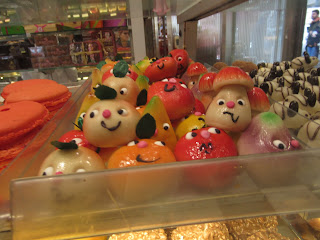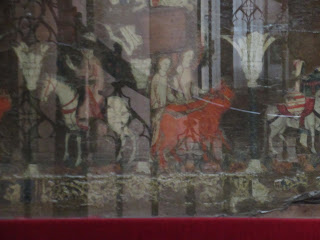After seeing a good chunk of both eastern and then northwestern Spain, it was great finally to reach Madrid, the country's hub and Europe's second highest capital, at more than 2,000 feet above sea level. In medieval times, the city was just another village, caught in between the powerful kingdoms of Castile and Aragon. When newlyweds King Ferdinand and Queen Isabella united the kingdoms in 1469, Madrid, sitting at the center of Spain, became the focal point of the country. By 1561, Spain ruled the world's most powerful empire and King Philip II moved his capital from tiny Toledo to the much larger Madrid. Successive kings transformed the city into the fabulous European capital we were excited to explore the next several days.
As we headed toward one of the city's major museums, we heard horns blaring nonstop from several blocks away and soon realized there was a large demonstration against the police but we didn't know why.
Months previously, we'd made reservations to tour the Thyssen-Bornemisza Museum to see the impressive collection that Baron Thyssen-Bornemisza, a wealthy German married to a former Miss Spain, sold to Spain for 350 million dollars. The museum, especially renowned for its Impressionist painters, opened in 1992.
These larger than life paintings were of former monarchs Juan Carlos 1 and Sofia, parents of the current king.
This man and woman were 58 and 56 respectively. I like to think I look less old than how this woman was portrayed!
I don't think I'd ever seen Edgar Degas paint horses before, just ballerinas.
I got pretty sick after a while of seeing the same dark peach tone on every wall and on every level in the museum!
Next we came across the Church and Convent of Corpus Christi built by a rich family in 1607 as the most important thing a noble family could do in 17th century Spain was to build and maintain a convent. The coat of arms in the central panel over the entrance depicted the donors kneeling before a communion wafer.
As we headed toward one of the city's major museums, we heard horns blaring nonstop from several blocks away and soon realized there was a large demonstration against the police but we didn't know why.
The demonstration was just a block away from the Congress of the Deputies, i.e. the lower house of the legislative branch.
Months previously, we'd made reservations to tour the Thyssen-Bornemisza Museum to see the impressive collection that Baron Thyssen-Bornemisza, a wealthy German married to a former Miss Spain, sold to Spain for 350 million dollars. The museum, especially renowned for its Impressionist painters, opened in 1992.
These larger than life paintings were of former monarchs Juan Carlos 1 and Sofia, parents of the current king.
I was drawn to this series of paintings called Saint Matthew the Evangelist by a German artist who lived in the latter half of the 15th century
I was also taken with the vibrant colors in the 14th century Triptych of the Holy Face:
These were so sharp, they looked like photos.
Rarely had I seen such an overtly religious tapestry.
This painting by Domenico Ghirlandaio was featured on all the museum's advertising and promotions. I liked it but would have been curious to know why it was selected.
Young Knight in a Landscape was painted in 1505.
I don't ever recall seeing this vivid lime green color used in paintings from the 1500s.
The Pair of Adoring Angels was created in 1510.
A pair of superb paintings by Canaletto side by side:
I was intrigued by the artist's wonderful use of light in these paintings.
A self-portrait by Rembrandt:
This was the first unusual bathroom sign I'd seen in a long time!
The collector's widow, Carmen Thyssen-Bornemisza, stated when she began to acquire works of art in the 1980s with a passion she owed to her husband, she was profoundly impressed by the remarkable capacity that works of art had to move and unite human beings. She'd always felt that art wasn't for one person alone and should be shared.
This man and woman were 58 and 56 respectively. I like to think I look less old than how this woman was portrayed!
Renoir's Wheatfields from 1879:
Ivy: I thought of you when I saw this pair of paintings by Monet from his early Impressionist period even though I know you and Alan had seen so many of his works in Paris recently.
Another Monet for you, Ivy, from his late Impressionist period!
I knew these could only be by Paul Gaugin who died in 1903 in his beloved Tahiti.
The museum had a sizable collection of works by North American artists. These were by Canadian native Maurice Prendergast but I had never heard of him before. Guess I've been away from Canada for too long now!
Edvard Munch's Geese in an Orchard was sure a far cry from his signature Scream painting!
This was by Edward Hopper, the American artist.
There were many paintings by Ernst Kirchner, possibly a German artist and therefore favored by the German Thyssen-Bornemisza, I thought. I'd never heard of the artist before.
This painting, Waterloo Bridge, was one of just twenty four listed on the museum's brochure but again I'd never heard of the artist, Andre Derain. It looked like fireworks over the bridge to me.
I didn't think we'd go through the entire museum and not see one of Degas' iconic dance paintings!
Three paintings by Van Gogh: It was mind boggling to think how much money the collector had to have paid for his mammoth collection of top-notch works by the world's best painters!
A sublime work by Renoir was next to the Van Gogh works in the 19th century European Impressionist Gallery.
In the basement, there was a group studying or perhaps learning about Hopper's painting of The Hotel Room. Only in the lower level were the walls a rather drab gray color that looked like a primer to me!
Another one of the museum's 'star paintings.' It was by Wassily Kandinsky, the Russian-born pioneer of abstract art.
There were lots and lots of school groups in the museum, some of them that may have been as young as kindergarten age. It was great seeing such young children being exposed to art.
I loved seeing this 1944 painting by Salvador Dali whose museum and home we'd had such great fun touring north of Barcelona a few weeks earlier. Surely the painting had the longest title of any work - Dream Caused by the Flight of a Bee Around a Pomegranate a Second Before Waking Up!
The work by Roy Lichtenstein and others in the Neo-Dada and Pop Art Gallery certainly showed the eclectic collection of works amassed by the museum's founder.
These sculptures by Auguste Rodin were the only ones we saw in the entire collection.
The museum's founder and his wife, an avid art collector in her own right:
Unlike Madrid's two other art museums, the Thyssen, as it was normally referred to as, had a wide-ranging collection based on the collectors' tastes rather than thematically grouped paintings. Being spread out in chronological order rather than grouping artists into sections, the museum was a great insight into the changing art styles over the years. I really liked the fact that I discovered several artists I hadn't seen featured in other collections. To think that this collection was at one time privately owned and was second in size only to the Queen of England’s own collection!
The demonstration that we'd seen before entering the museum more than two hours previously, seemed to have grown considerably as we exited in terms of crowds, their volume and also blocking cars from driving on several streets. Luckily, there was a significant police presence so we never felt in any danger.
As some of you know or might have guessed, I have a sweet tooth so the fancy pastry shop window with the revolving trays of goodies caught my eye!
When I showed Steven my newly wrapped donut, he commented the shop surely should have wrapped it for the price I paid! He wasn't complaining too much a little later when he got to eat at least half of the confection!
If you're familiar with any of Rick Steves' travel books, you know he always suggests great walks people take when visiting a new city. To get a sense of Madrid's historic center, we followed part of his Puerta Del Sol or Gate of the Sun walk which started in the bustling square of the same name. The square was named for a long-gone gate with the rising sun carved onto it. The famous Tio Pepe sign has advertised a local sherry wine since the 1930s.
The equestrian statue in the center of the square honored King Charles III whose enlightened urban policies gave him the nickname of 'the best mayor of Madrid.' He was the one who, in in the latter part of the 18th century, set up the public school system, mandated underground sewers, made the Royal Palace the wonder of Europe, built the Prado Museum and basically cleaned up Madrid.
The red and white building facing the square was the city's first post office which Charles III founded in the 1760s. Now the county governor's office, the building was notorious for once having been dictator Francisco Franco's headquarters. Sadly, too many of those detained and interrogated by the Franco police 'escaped' by jumping out its windows to their deaths.
I loved reading that on New Year's Eve, as the bell atop the building chimes 12 times, the locals eat one grape for each ring to bring good luck through each of the next 12 months!
In front of the entrance to the governor's office we stood on a marker symbolizing 'kilometer zero,' the symbolic center of Spain with the country's six major highways indicated.
Just up the street was a statue of a bear pawing a tree - a symbol of Madrid since medieval times!
I think this was the first time in Spain we'd noticed many street vendors, all of whom appeared to be recent North African immigrants, quickly collecting purses, shoes, etc that had been displayed on the sidewalk when they saw police officers arriving. We later saw many, many vendors just like these young men who had items on tarps with strings on each corner so they could pick everything up in a matter of seconds.
On the corner of the square was a famous bakery, founded in 1864, that was famous for its cream-filled Napolitana pastry.
The Napolitana had Steven's name written all over it!
The street sign showed the post coach heading for the first post office. Medieval street signs located throughout Madrid on the lower corners of buildings included pictures so the illiterate could 'read' them.
I loved looking at so many buildings that had such colorful designs on them.
In early modern times, Plaza Mayor was Madrid's main square. It served as the city's 17th century open-air theater with bullfights, fires, royal pageantry and events from the gruesome Inquisition taking place.
Worn reliefs on seats in the square illustrated the story of that sad chapter in Spain's history when suspected heretics, Protestants, Jews, and Muslims whose 'conversion' to Christianity was doubted. The guilty were paraded around the square before their executions, wearing billboards listing their many transgressions. It was distressing to learn that criminals were slowly strangled while up to 50,000 people, including the wealthy who rented balconies, crowded into the square to watch the horrifying spectacle.
This equestrian statue honored King Philip II who, in 1619, transformed the old marketplace into the lovely plaza.
I don't know about you but I have always loved street performers like this one who dress up in amazing outfits or who strike unusual poses to earn a few euros. I tend to want to watch them for a while but Steven doesn't, so I have to run and catch up with him in a bit every time I see one!
Not far away was the iron and glass Mercado de San Miguel from 1916 that stood on the spot of an even earlier market. The city's oldest surviving market hall had lots of high-end vendors of fresh produce, gourmet foods and tapas that was enjoyable walking through as everything was so colorful and artistically arranged. What a feast it was for our eyes as well as noses!
Ivy: Ben would have loved this olive bar!
The olives skewered on a toothpick were called banderillas for the decorated spear a bullfighter thrusts into the bull's neck. Think of that the next time you eat an olive!
Next we came across the Church and Convent of Corpus Christi built by a rich family in 1607 as the most important thing a noble family could do in 17th century Spain was to build and maintain a convent. The coat of arms in the central panel over the entrance depicted the donors kneeling before a communion wafer.
We could buy baked goodies from the cloistered nuns if we rang the buzzer by the door and then were granted entrance. It involved then walking inside to a lazy Susan that allows the nuns to sell their cookies without being seen. I did go inside but the only ones available were pastas de almendra or almond cookies, which Steven is allergic to and I don't like. The cost for just a pound would have been more than ten bucks, a little rich for my blood to justify buying, even if it would have been a fun story to tell!
We'd seen this same Canadian a couple weeks ago when we were both visiting Montserrat, north of Barcelona - what a small world!
We knew from the sign - and a little help from Rick Steves! - that on Calle de Codo those in past centuries in need of bits of armor shopped there.
Before entering the next plaza, we saw this old door, made of wood lined with metal, and considered to be the oldest door on Madrid's oldest building and inhabited since 1640! Where on earth does Rick Steves come up these fascinating bits of arcane trivia?!
In the Plaza de la Villa was Madrid's Town Hall which showcased the city's distinctive architectural style with symmetrical square towers and topped with steeples and a slate roof.
Over the doorway were the three coats of arms that marked many symbols of Madrid's rulers: the castles of Castile in the center, and the city symbol of a berry-eating bear as well as Habsburg crowns. Why and when, I wondered, had that become the city's symbol?
In an assassination attempt in 1906, an anarchist - now referred to as a terrorist - threw a bouquet tied to a bomb from a balcony on this building across the street at King Alfonso XIII and his bride as they paraded by on their wedding day. The newlyweds were sparred but 28 people were killed. Happily, the king and queen went on to live a long life, producing many great-grandchildren, including the current king, Felipe VI.
The Assassination Attempt Memorial:
Not surprisingly, the Institute of Italian Culture had some glorious frescoes on its upper facade.
Just down the street was Madrid's massive gray and white Almudena Cathedral. At 110 yards long and 80 yards high, it only opened in 1993, 100 years after workers started building it.
Just beyond the brightly colored dome was the altar and then very colorful paintings that were rushed to completion for the visit by Pope John Paul II in 1993. He came to consecrate the cathedral, thus ending 300 years of requests for Madrid to have a cathedral of its own. Never had I seen such bright paintings in a cathedral and I loved their vibrancy, and the fact they were so different from so many other churches we've seen in so many places.
I felt very fortunate being able to walk up the right transept to revere a 15th century Gothic altarpiece with a stunning statue of the Virgin Mary, that was the more remarkable considering its placement in the new cathedral.
The church's historical highlight was the 13th century empty coffin that was painted leather on wood of Madrid's patron saint, Isidro. The very devout, humble farmer was said to have been helped by angels who did the plowing for him while he prayed. Forty years after he died, this coffin was opened, and it was discovered that his body had been miraculously preserved. That convinced the pope to canonize Isidro as the city's patron.
I really found it interesting that the ceiling was decorated with modern geometric patterns rather than the traditional old masters and religious scenes.
In the church's nave was the cathedral's glittering 5,000 pipe organ. I really appreciated seeing signs asking for silence which people respected, so the worship area had a sense of calm and quiet which was welcome. I was struck that, though the exterior suggested that it was an old building, the interior was quite modern yet still reflected and honored the past.
Once we walked around the church to its rarely used front door, we faced the imposing Royal Palace, the subject of the next post as this one has been long enough already! We decided to save a visit to the cathedral's Crypt until another day; that turned out to be one of the highlights in Madrid, strange as that may sound!
Next post: Visiting the Palacio Real or Royal Palace still later that day!
Posted on January 7th, 2019, from Denver.
























































































































No comments:
Post a Comment